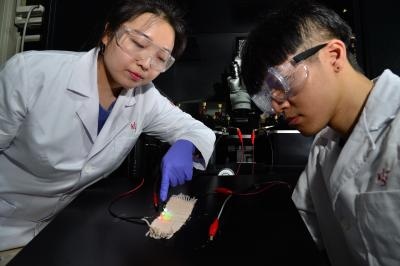Jun 24 2019
The strong establishment of the wearable electronic device market in the 21st century has led to dynamic research on electronic textiles—textiles (for example, clothing) that can operate like electronic devices.
 It is conducting experiments that use a new electronic textile to drive LEDs in RGB color. (Image credit: Korea Institute of Science and Technology (KIST))
It is conducting experiments that use a new electronic textile to drive LEDs in RGB color. (Image credit: Korea Institute of Science and Technology (KIST))
Since fabric-based things are flexible and can be worn comfortably throughout the day, they are the appropriate platform for wearable electronic devices.
The group of scientists led by Dr Jung-ah Lim of the Korea Institute of Science and Technology (KIST, president: Byung-gwon Lee) has reported the development of a fibrous transistor with a fiber structure, offering it the characteristics of a textile while also enabling it to be attached into clothing and maintaining a sufficient level of functionality even after washing.
In the present technology, a solid electronic device (sensor and so on) is physically attached to the surface of clothing or various devices are linked with the help of conductive textiles, with little to no care about the wearer’s comfort. Current thread-type transistors are developed by laying a flat transistor onto a single conductive thread.
Electrodes developed in this way need a high voltage for being activated, but the low current that is produced is usually inadequate to trigger display devices (LED and so on.). So far, it has been challenging to make electronic circuits through contact with other devices (for woven fabrics) or to incorporate a protective layer into the transistor to enable washing.
The transistor created by the KIST research group is developed by linking twisted electrodes. This structure allowed the team to alter the thickness of the semiconductor and length of the threads to yield currents about 1000 times higher than those obtained with current transistors, even at low voltages (below −1.3V).
By carrying out the tests, Lim’s group verified that even if the transistor was bent or coiled around a cylindrical object over 1000 times (with a resulting thickness of around 7 mm), it retained a performance level of more than 80%.
Furthermore, the group announced that the performance level remained sufficient even after the transistor was washed in water containing detergent. Additionally, the team was able to trigger an LED device with the transistor inserted between the threads of clothing and measure electrocardiogram signals by means of signal amplification.
The results of this study point to a new device structure that can overcome the limitations of current electronic textiles, including low current, high activation voltage, and low resilience to washing. We expect that our study will contribute to the development of even smarter wearable products in the future, including next-generation wearable computers and smart clothing that can monitor vital signs.
Dr Jung-ah Lim, Korea Institute of Science and Technology
This research was carried out with support from the Ministry of Science and Technology (minister: Young-min Yoo) as a project of KIST and the National Research Foundation of Korea. The results of this research were reported in the latest online issue (Issue 31, No. 23) of Advanced Materials (IF: 21.950, top 1.020% of JCR sector), a well-known international journal on materials.